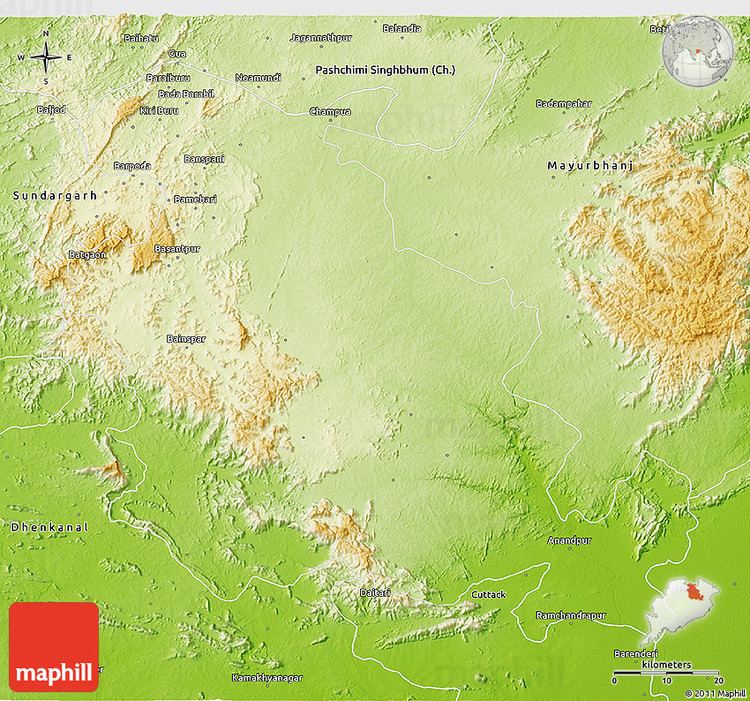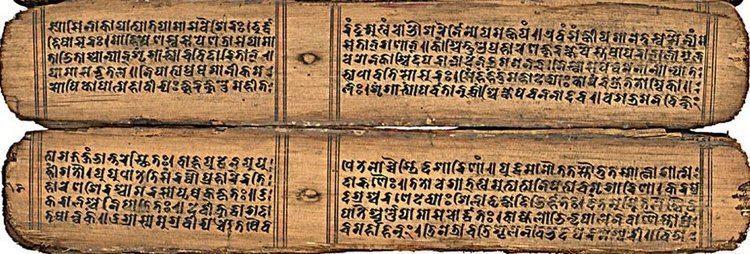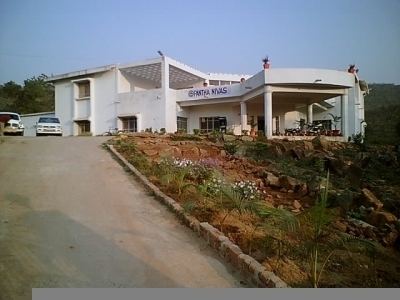Country State | Language spoken Oriya District Kheonjhar | |
 | ||
Map of Kendujhar
Kendujhar is a town with municipality in Kendujhar District in the Indian state of Odisha. It is the administrative headquarters of the Kendujhar district, and it is one of the 5th scheduled areas of Odisha. There are 21 wards in the city, among them Kendujhar Ward No 09 is the most populous ward with population of 4,184 and Kendujhar Ward No 03 is the least populous ward with population of 1,676.
Contents
- Map of Kendujhar
- Geography
- Demographics
- History
- Keonjhar State
- Predecessors and Genealogy Tree
- Education
- Politics
- Transport
- References

The nearest railway station is Kendujhar which is within the city. Yearly average rainfall of the city is 1477.2 mm. Maximum temperature here reaches up to 44°C and minimum temperature goes down to 9°C.

Geography
Keonjhar is a land locked district with an area of 8240 km2. It is situated in the northern part of Odisha. It is surrounded by Singhbhum district of Jharkhand in the North, Jajpur in the South, Dhenkanal, Angul and Sundargarh in the West and Mayurbhanj and Bhadrak in the East. It lies between 21°1'N and 22°10'N latitudes, between 85°11'E and 86°22'E longitude and at 480 meter altitude. Baitrani river originate from Keonjhar plateau.The National Highway-215 passing through Keonjhargarh approximately bi-sects the district into two similar natural regions. To the East of this Highway are the planes of Anandapur and a portion of Sadar Sub-division. To the West is a range of lofty hills which contains some of the highest peaks of Orissa namely Gandhamardan (3477 ft.), Machakandana (3639 ft.), Gonasika ( 3219 ft.) and Thakurani ( 3003 ft.). About half of the area of this district spreading about 4043 sq. km. is covered by forests of Northern tropical moist deciduous type and contains Sal, Asan, Piasal, etc. The river Baitarani comes out of Gonasika Hills and flows to the north touching the border of Singhbhum district of Jharkhand. It again flows East entering Anandapur Sub-division and the district of Bhadrak. The soil is mostly red throughout the district and in the South there is a small patch of black cotton soil. The important minerals available in huge quantity in the district are Iron-ore, Manganese and Chromites.The district consists of a compact area and its extreme length from north to south is nearly 145 km. The average breadth from East to West is about 65 km. It is divided into two widely dissimilar tracts-the lower Kendujhar and the upper Kendujhar. The former is a region of valleys and low lands, while the latter includes mountainous highlands with a general slope from North to South. The highlands consisting of clusters of rugged crags afford a safe retreat to its inhabitants in troubled times. The mountaintops appear from the low lands to be sharply ridged or peaked, but in reality they have extensive tablelands on their summits, fit both for pasture and for tillage. The average elevation in its central part is about 500m. At places, isolated hills rise abruptly from the plains. But most of the areas have a general elevation of over 600m. which forms the watershed of some rivers. The Baitarani River takes its rise in the hilly North Western division. In between these two natural divisions passes the State Highway from Chainbasa to Jajpur Road through the headquarters, Kendujhargarh.
Demographics
The city is home to about 61 thousand people, among them about 31 thousand (52%) are male and about 29 thousand (48%) are female. Child (aged under 6 years) population of Kendujhar municipality is 11%, among them 52% are boys and 48% are girls. There are about 14 thousand households in the city and an average 4 persons live in every family.Hindus contribute 95% of the total population and are the largest religious community in the city followed by Muslims which contribute 4% of the total population.
Population of the city has increased by 16.9% in last 10 years. In 2001 census total population here were about 52 thousand. Female population growth rate of the city is 19.5% which is 5% higher than male population growth rate of 14.5%. General caste population has increased by 18%; Schedule caste population has increased by 16.7%; Schedule Tribe population has increased by 14% and child population has increased by 9.8% in the city since last census.63% of the whole population are from general caste, 13% are from schedule caste and 23% are schedule tribes.
As of 2011 census there are 925 females per 1000 male in the city. Sex ratio in general caste is 906, in schedule caste is 984 and in schedule tribe is 944. There are 940 girls under 6 years of age per 1000 boys of the same age in the city. Overall sex ratio in the city has increased by 39 females per 1000 male during the years from 2001 to 2011. Child sex ratio here has increased by 10 girls per 1000 boys during the same time.
Total about 47 thousand people in the city are literate, among them about 26 thousand are male and about 21 thousand are female. Literacy rate (children under 6 are excluded) of Kendujhar is 87%. 92% of male and 82% of female population are literate here. Overall literacy rate in the city has increased by 5%. Male literacy has gone up by 3% and female literacy rate has gone up by 7%.
Kendujhar has 34% (about 20 thousand) population engaged in either main or marginal works. 53% male and 13% female population are working population. 48% of total male population are main (full time) workers and 4% are marginal (part time) workers. For women 10% of total female population are main and 3% are marginal workers.
History
Following the integration of the feudatory states with Odisha on 1 January 1948 the erstwhile princely state of Keonjhar emerged as one of its districts with its headquarters at Keonjhargarh and since then it is continuing as such. The whole district of Keonjhar was a princely state before its merger with Odisha. The early history of the State is not adequately known. It was most probably a part of the old Khijjinga territory with headquarters at Khijjinga Kota, identified with modern Khiching. It became a separate state with Jyoti Bhanja as its ruling chief in the first half of the 12th century A.D. The then State of Keonjhar comprised only the northern half of the modern district for a long time prior to the installation of Jyoti Bhanja as King. During the latter part of the 15th century the southern half was occupied by King Govinda Bhanja under whose rule Keonjhar was extended from Singbhum in the north to Sukinda(a Zamindari in Cuttack district) in the South and from Mayurbhanj in the East to the borders of the States of Bonai, Pallahara and Anugul in the West. During the rule of Pratap Balabhadra Bhanja (1764-1792 A.D.) two small areas of Tillo and Jujhpada were purchased from the Zamindar of Kantajhari and were added to the State. These were recognised as parts of Keonjhar in the Sanad granted by the East India Company to Raja Janardan Bhanj in 1804. Since then there had been no territorial changes of the State till its merger with the Province of Odisha. But after merger largely for the reasons of administrative expediency the areas of Tillo (7.51 km2) and Jujhpada (9.06sq.km.) were transferred to the districts of Baleshwar and Cuttack respectively, while a number of villages called Ambo group (14.84 km2.) of Balasore district were added to Keonjhar district.
Keonjhar State
Founded sometime in the first half of the 12th century, the founder being Jati Singh (Jyoti Bhanj), brother of Adi Singh (Adi Bhanj), founder of Mayurbhanj State. A slightly different version goes like this:- "Jai Singh, a son of Man Singh, the Maharaja of Jaipur in Rajputana, came to visit the shrine of Jagannath in Puri. He married Padmavati, the daughter of the Gajapati King of Puri, Pratapendra Deb, and received as her dowry the State of Hariharpur, which then comprised the two States of Moharbhanj and Keunjhar. Two sons were born to him, the elder of whom was named Adi Singh and the younger Joti Singh. In mauza Rarua in kila Hariharpur, there was a petty Zamindar named Mayura Dhwaja in possession of five pirs. He was conquered by Prince Adi Singh, and deprived of his Zamindari. The Gajapati King of Puri, hearing of the success of Prince Adi Singh, conferred on him the title of Bhanj." The Maharaja maintains a military force of 2949 infantry and 32 guns (as of 1892).
Predecessors and Genealogy Tree
Raja PRITISH BARIK, Raja of Keonjhar fl.1480 ...... Raja JAGANNATH BHANJ, 35th Raja of Keonjhar 1688/1700 Raja RAGHUNATH BHANJ, 36th Raja of Keonjhar 1700/1719 Raja GOPINATH BHANJ, 37th Raja of Keonjhar 1719/1736 Raja NARSINGH NARAYAN BHANJ, 38th Raja of Keonjhar 1736/1757, married and had issue. Raja Daneshwar Narayan Bhanj (qv) [?Raja Chakradhar Bhanj, adopted by Raja Raghunath Bhanj of Mayurbhanj] Raja DANESHWAR NARAYAN BHANJ, 39th Raja of Keonjhar 1757/1758 Raja JAGATESHWAR NARAYAN BHANJ, 40th Raja of Keonjhar 1758/1762 Raja PRATAP BALBHADRA BHANJ, 41st Raja of Keonjhar 1764/1792 or 1762/1797, married and had issue. Raja Janardhan Bhanj (qv) Raja Tribikram Bhanj, adopted by the Raja of Mayurbhanj. Raja JANARDAN BHANJ, 42nd Raja of Keonjhar 1794/1825 or 1797/1832, he received the estate of Pal-Lahara as dowry, but the people there objected to his succession and Pal-Lahara subsequently became independent, married 1794, Rani Krishnapriya, died 1825, daughter of Raja Municipal of Pal-Lahara, and had issue. Raja GADADHAR NARAYAN BHANJ Deo, 43rd Raja of Keonjhar 1825/1861 or 1832/1861, married (a), Senior Rani Bishnupriya, married (b), a daughter of Kunwar Ajambar Singh of Seraikella, and had adoptive issue, as well as natural issue. He died spl in March 1861. (A) Kumar Brundaban Bhanj Deo, adopted by Rani Bishnupriya, as the intended successor, but he was not recognized as such by the British Authorities. Maharaja DHANURJAI NARAYAN BHANJ Deo, 44th Raja of Keonjhar 1861/1905, born 27 July 1849, he succeeded to the gadi on 4 September 1861 (), he was formally confirmed in the title of Raja as a hereditary distinction in 1874 and the title of Maharaja was granted on 1 January 1877 as a personal distinction, married and had issue. Raja Gopinath Narayan Bhanj Deo (qv) Routrai Saheb Basudev Bhanj Deo, married and had issue. Kumar Janardan Bhanj Deo, educated at Rajkumar College, Raipur (Undergraduate); entered politics after the merger of the Princely States into the Republic of India; M.L.A. (Orissa) 1952/1965 (three terms); interests were Reading, Sports, Shooting and Horse riding; married Kumari Sarada Sundari Devi, and had issue, one son and two daughters. He died 1 May 1965. Prabir Bhanj Deo Kumar Radheshyam Bhanj Deo. Prasanta Bhanj Deo Mukesh Kumar Bhanj Deo Pratap Bhanj Deo Pradyumna Bhanj Deo Raja GOPINATH NARAYAN BHANJ Deo, 45th Raja of Keonjhar [27.10.1905] - [12.8.1926], born 3 February 1883, he succeeded to the gadi on 27 October 1905, married and had issue. He died 12 August 1926. Raja Shri Balbhadra Narayan Bhanja Deo (qv) Chotrai Saheb Shri Laxmi Narayan Bhanj Deo M.A., born 25 July 1912, educated at Rajkumar College, Raipur; M.L.A. (Orissa) 1946/1957 (two terms); Member of the Lok Sabha; Development Commissioner, Keonjhar; Revenue Minister, Keonjhar (xx.8.1945) - (xx.6.1947); Chief Minister, Keonjhar in 1947 (June to December); Nominated Member, Orissa Legislative Assembly 19491952; Member, Orissa State Red Cross Society; Member, Nrutya Natyakala Parishad, Orissa; Member of Senate, Utkal University since its inception till February 1948; an Elected Fellow from Registered Graduates Constituency till 1952; Fellow, Royal Economic Society and Royal Society of Arts, London; Member, South Club, Calcutta; National Sports Club, New Delhi; and Gymkhana Club, New Delhi; interests were Shikar and Photography, Motoring and Travel; married A. Sau. Preemlatika Raje, and had issue, one son and three daughters. He died 9 July 1986. Raja Shri Anant Narayan Bhanja Deo (qv) Rajkumari (name unknown), married (as his first wife), Raja Kishor Chandra Deo Samant of Athmalik. Raja Shri BALBHADRA NARAYAN BHANJA Deo, 46th Raja of Keonjhar [12.8.1926] - , born 26 December 1905 and succeeded 12 August 1926, educated at Rajkumar College, Raipur; married Rani Manoj Manjari Devi, daughter of Raja Sriram Chandra Singh Deo of Kharsawan, and his wife, Rani Giriraj Devi, and had issue, one son and one daughter. Raja Shri Nrusingh Narayan Bhanj Deo (qv) Rani Swarna Prabha Manjari Devi, married Raja Prasanna Chandra Deo, Raja Saheb of Jarada, second son of Raja Hrudaya Chandra Dev Birabar Harichandan Mahapatra of Talcher, and had issue, three daughters and two sons. She died 2005. Raja Shri NRUSINGH NARAYAN BHANJ Deo, 47th Raja of Keonjhar fl.1970, married (div.), a daughter of HH Thakore Saheb Shri Pradyumansinhji Lakhajirajsinhji of Rajkot, and his wife, HH Thakorani Padma Kunverba Sahiba, no issue. He died after 1970. Raja Shri ANANT NARAYAN BHANJA Deo, 48th Raja of Keonjhar (see above)
Education
Colleges in Kendujhar city includes:
The schools in Keonjhar include:
Baunsuli High School Govt Of india
Politics
Er. Subarna Naik of BJD is the current MLA from Keonjhar assembly constituency. Mohan Charan Majhi won assembly elections in both 2004 and 2000. Earlier MLAs from this seat were Jogendra Naik of BJP (1995), C. Majhi of JD (1990), Chhotaray Majhi of JNP (1985), Jogendra Naik of INC(I) in 1980 and Kumar Majhi of JNP (1977).
Present MP from Keonjhar (Lok Sabha constituency) is Y.N.S. Laguri of BJD. Bausuli High School Govt of
Transport
Kendujhar is situated the National Highway No 49 (formerly it was 6) and 215.
Kendujhar railway station is on the Padapahar-Jakhapura branch line of Tatanagar–Bilaspur section of Howrah-Nagpur-Mumbai line.
It is connected by broadgauge line to Jakhpura. Nearest airport is Bhubaneswar (220 km)
Sr. No Train Name and Number Start Time End Time
Barbil Station
1 Chakradharpur-Barbil Intercity Express/18403 05:15 am 07:50 am2 Barbil Janshabatdi/12021 06:20 am 13:05 pm3 Tatanagar-Barbil Passenger/58103 17:00 Pm 21:20 pm4 Barbil-Puri Express/ 18415 6:30 pm 20:30 pmEven 4 trains are running through Kendujhar Garh railway station, there is no trains in night time connecting to Bhubaneswar. So people depend on night bus transport only.
Bhadrak Station
5 Balasore - Bhadrak Passenger/58029 13:40 pm 15:35 pmJajpur-Keonjhor Station
1 Kharagpur-Jajpur Keonjhar Road Passenger/58009 15:55 pm 20:50pm all days 2 Yesvantpur-Howrah SF Express/12864 12:10 PM 12:12 PM (for Bengaluru Route)all days3 Purushottam SF Express/12802 1:47 AM 1:49 AM (for Delhi Route) all days4 Guwahati Ernakulam Express/05624 9:44 AM 9:45 AM (for Ernakulum Route)Saturday for Ernakulam,Monday for Guwahati5 Chennai-Howrah SF Mail/12850 10:15 AM 10:16 AM (for Chennai Route) all days6 There are several trains for Kolkata, important ones are Janshatabdi, Dhauli Express, HWH-Puri Express,Jagannath ExpressJakhapura Station
Although Jakhapura Station is connected with Keonjhor on the coastal part of Odisha but no express train halt. Only passenger trains for Jajpur Keonjhor Road are available. Even the road link to Jajpur Keonjhor Road is very poor.1 Kharagpur-Jajpur Keonjhar Road Passenger/58009 15:55 pm 20:50pm all days2 Yesvantpur-Howrah SF Express/12864 12:10 PM 12:12 PM (for Bengaluru Route)all days3 Purushottam SFKeonjhar Station
1 Keonjhar-Bbsr Fast Passenger /58425 5:30 am 11:20 am2 Barbil-Puri Express/ 18415 13:10 pm 20:30 pm3 Visakhapatnam-Tata Special via Keonjhar 18516 Up 18515 Tata-Visakhapatnam Down(limited run).